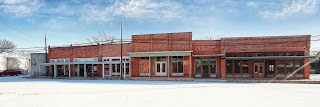MARTINDALE HISTORIC MAIN STREET, LLC.
Downtown Martindale Properties owned by Carlton Cart
All Properties are Zoned Multi-Use (MU), which permits most commercial uses. The Ci1y of Martindale In November, 2010, approved the sale of alcoholic beverages in restaurants and for off-premises.
Martindale Mercantile Company
404-A Main Street
Approximately 9,000 square feet plus loading docks and awning-covered gallery sidewalk. Currently un-renovated. Long leaf pine floors, tin ceiling (replacement tiles available). Includes courtroom movie set location.
Merchants and Planters Bank
404·B Main Street
Approximately 2,000 square feet plus common bathroom area, back hallway and storage space plus loading dock. Long leaf pine and mosaic tile floors. Includes unique double split-level vaults. Renovated space currently rented as photography studio and gallery, Summer Maulden Photography.
George Norman Martindale, the grandson of George and Nancy Martindale who founding the City of MartlndaJe in 1855, built the largest of Martindale's general stores from the finest D'Hanis red brick 1n about 1910. Employing vernacular commercial architecture, the building has 16 foot ceilings, a tong, awning-covered gallery sidewalk, and surface-mounted cast-iron columns framing the doorways. Many of the large storefront plate glass windows and au of the doors and hardware are original. The entire exterior of the building has been renovated: New roof, re-polnted brick throughout, wood trim and cast-iron elements painted In period colors. The property also Includes six large seed silos, a grain elevator, more than two acres of unimproved land and more than 300 feet of high-bank frontage on the San Marcos River.
Harper Brothers Store and Warehouse
417 Main Street and 103 Gonzalez Street
Approximately 4,200 square feet in store and 1,500 square feet In warehouse. After falling Into disrepair, the store building,origlnally constructed by Benjamin Franklin Harper and operated as a general store for more than 62 years, the external elements of the building were completely rebuilt and restored with a new roof and skylight, new marble-stained concrete floor,
re-polnted brick, wood trim painted In period colors and made handicap-accessible In 2009. Buildings have access to large common bathrooms in the adjacent Carl Building, newly constructed In a design compatible with streetscape In 2009. A portion of the flooring has been omitted to permit the construction of a restaurant kitchen to tenant's specifications. In addition to the double door entry to the Harper Store from Main Street, there is a handicap accessible double door entry facing the patio and Gonzalez Street, a service door entry In the rear, and access to the common areas and bathroom facilities In rear of the Carl Building. The warehouse building has been partially restored. The property also Includes a large outdoor patio area at the comer
of Main and Gonzalez Streets.
Carl Building
415 Main Street
Approximately 1,500 square feet of finished space, built In 2009 by owner Carlton Carl to a design compatible with the historic streetscape and adjacent buildings. Formerly an alleyway between the Crook Store and the Harper Brothers Store, the space was enclosed when the Harper Store was restored. The building contains two distinct separately metered spaces: the approximately 750 square foot storefront office or shop space (currently used by the owner as the office for his real estate brokerage and teasing business and for Martindale Historic Ma1n Street, LL.C.) and a handicap accessible bathroom as well as attic storage; and approximately 750 square feet of common bath room facilities, also handicap accessible, adequate to serve
the bathroom requirements of the Harper Store/Warehouse and the Crook Store and accessible from both.
Crook Store
413 Main Street
Approximately 3,200 square feet of space. Hardy Crook, one of Martindale's first merchants bull! the D'Hanis red brick general store around the turn of the 20th Century. The building features long leaf pine flooring, plank walls, Tin ceilings. new roof and skylight, as well as a loading dock/storage area at the rear. Cast-Iron columns support the sidewalk awning. In recent years,
several wedding receptions and private parties have been held in the building, which has access to the common areas and bathrooms at the rear of the Carl Building.
Crook Building
(Carpenter Sandwich Shop-a film/location designation)
411 Main Street
Approximately 1 ,000 square feet of space. Around 1920, Hardy Crook built the building of D'Hanis red brick adjacent to his dry goods store and set up one of his sons In business as a barber. The storefront (which, because of movie location sleight of hand appears at first glance to be a vintage sandwich shop with long-ago food prices) has, over the years, housed a diner, an
Insurance office, and an antique store, as well as a food bank and community meetings.
Cottonseed House
(Noodle Shad-a film location designation)
401-405 Main Street
Approximately 3,700 square feet of space. This corrugated tin building was constructed around 1950 with long leaf pine flooring and bins which were used for grain and seed storage. The property also Includes 10 large seed silos and space for parking or an outdoor (perhaps trellised) patio.
The Harper Seed Company Office and Warehouse
101 -103 Austin Street
Approximately 6,500 square feet of space. Over the years since Its founding In 1855, Martindale became, by some reckoning, "The Cottonseed Capitol of the World." It was also a center for hybrid com. By the 1950s, Harper Seed Farms, founded by R. M. Harper In 1928, had become the largest supplier of hybrid cotton and corn seed In Texas. B.A and Emmett Harper built the wood clapboard and corrugated tin Harper Seed Company Office and Warehouse to serve as the company's International offices. It Included air conditioning. a large vault and a sprawling warehouse space. The property Includes a large outdoor area shaded by huge pecan trees-a potential patio area-and most of the privately owned Austin Street.

